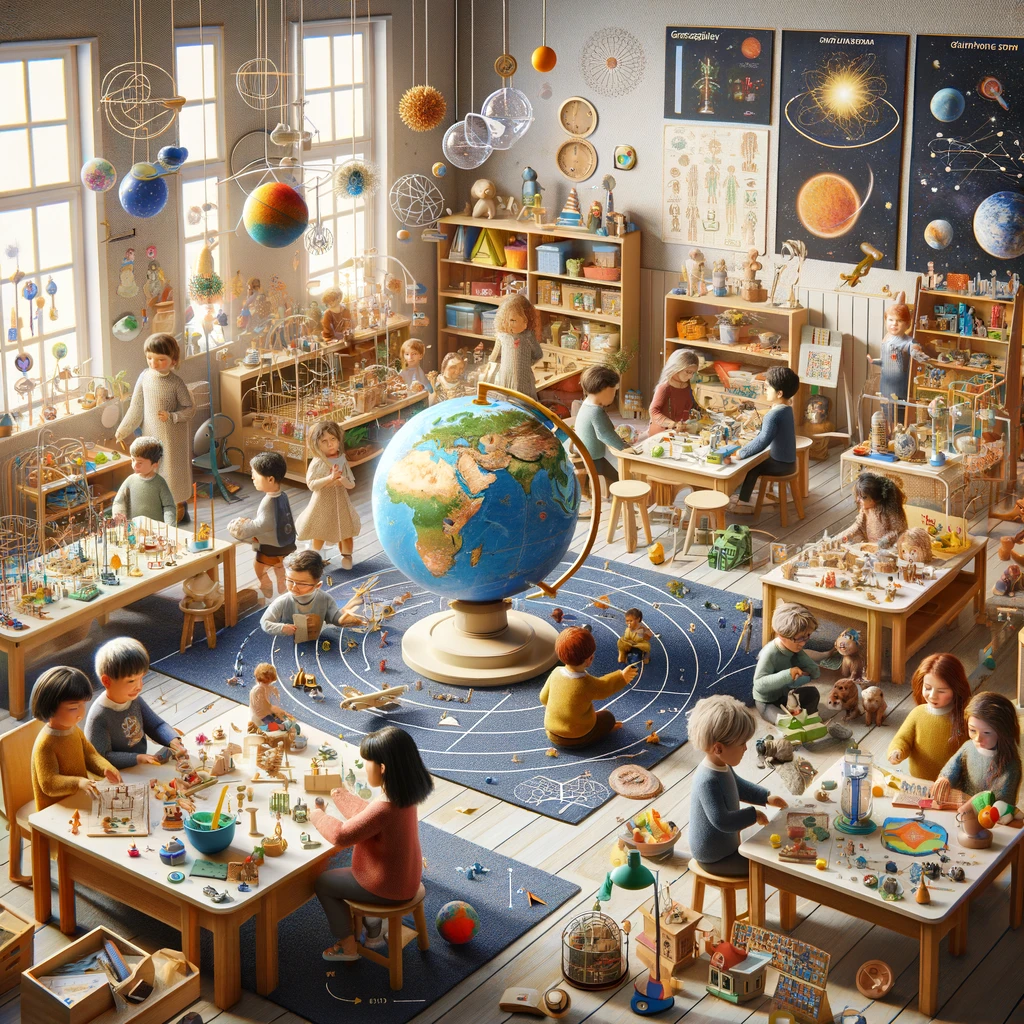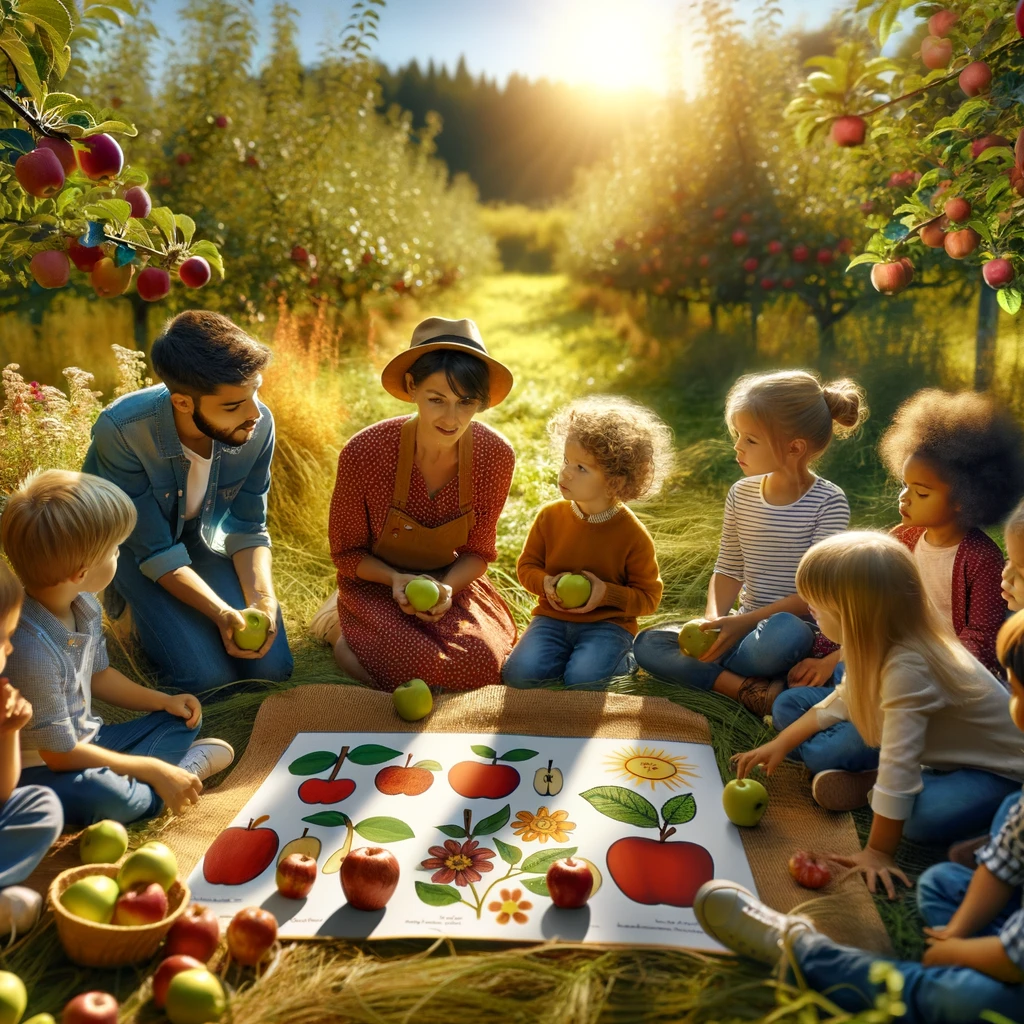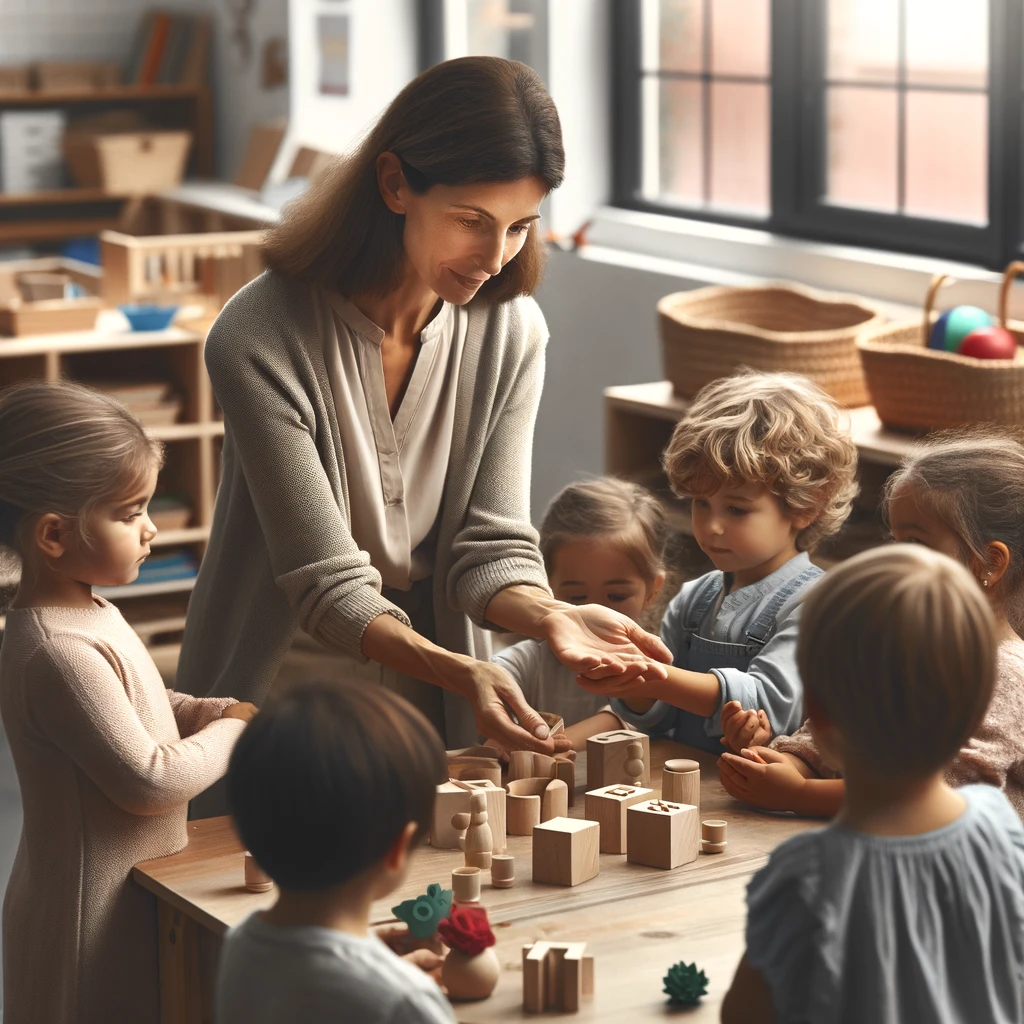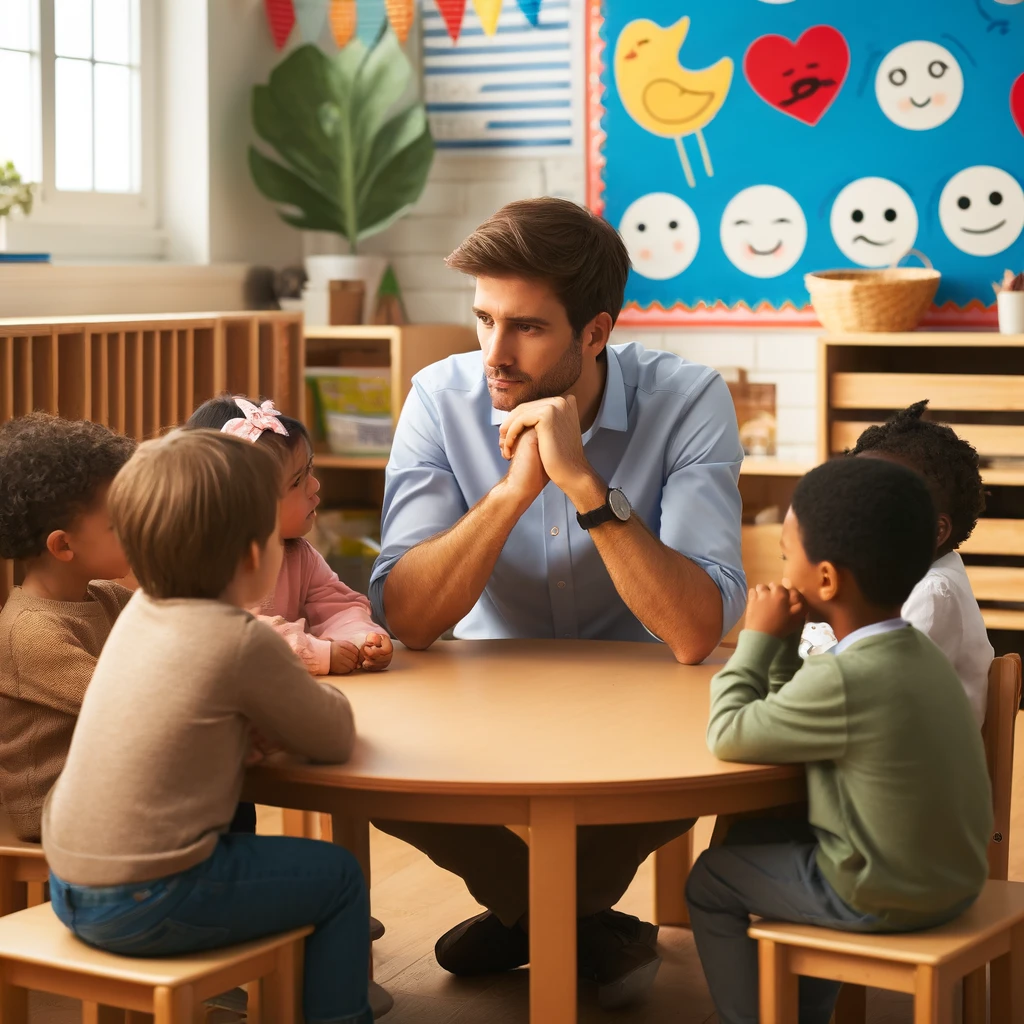Montessori Cosmic Education is a transformative method that encourages kids to explore the interconnections inside the universe and apprehend their area in it. This instructional approach, pioneered with the aid of Maria Montessori, seeks to encourage a experience of surprise and responsibility thru a holistic curriculum that integrates topics inclusive of technological know-how, records, geography, and arts. By engaging college students on this expansive view of studying, Montessori Cosmic Education aims to cultivate not handiest educational skills but also a deep respect for the natural global and a lifelong interest approximately the universe.
Indirect Preparation for formal Montessori Cosmic Education
The children between 3 to 6 years of age can be indirectly familiarized with the concept of peace and cosmic education, which develop the basis for more formal cosmic and peace studies during the elementary years. We already know that the Montessori system lays a strong emphasis on indirect preparation of children for future learning.
For instance, one of the indirect aims of the Cylinder Blocks is to prepare the child’s hand for proper pencil holding and writing. Similarly, though cosmic and peace objectives are embedded into Montessori classroom activities and practices, we indirectly prepare the child for advanced learning in the later years.
Integrated Approach to Cosmic Education
The key to success in a cosmic education program is that it should not be regarded as a separate subject. An effective cosmic program always blends itself with all subjects. In the early childhood (3-6 years) program, cosmic education is initiated indirectly by strengthening the child’s natural connections to himself, the earth, nature, and other people through the exercises of EPL, sensory discrimination, culture, etc.
Cosmic Education is formally introduced in primary (age 6-12 years) but the directress should be aware and sensitive towards this issue even prior to this age. The directress should keep in mind that the real purpose of education is more spiritual rather than just mastering some skills. Children aging 3 to 6 years also experience interconnectedness and interdependence of all living and nonliving things but in a very practical way which is different from the way in which the 6 to 12 year – old will experience it.

Children between 3 and 6 years of age are in their sensitive period of stronger connectivity with the natural world. They are always absorbed in the environment around them. At this stage, to lay the foundation for cosmic education, the teacher needs to make sure that the child experiences the natural world as much as possible. The teacher must realize that the child’s choice of material, concentrated activity and connection with the natural environment are crucial for development of a normalized personality with inbuilt characteristics of peace.
Materials used in a Montessori classroom are normally made up of natural material such as wood, sand, etc. while working with these materials the directress can refer to the origins of these materials. For example, while with baric tables the director can describe that the three different types of tablets are made up of three different types of wood, which come from three different kinds of trees.
Similarly, in the case of thermic tablets, which are made up of different materials, the director can describe how different kinds of matter came from the same source and discuss issues like the role of human beings in the collection and processing of these materials, conservation and recycling are crucial for developing a positive personality.
Vital Period to Experience Peace
We all know that 3 to 6 is the age when the child’s personality traits are determined. Thus, a practical form of sensitivity towards the connectedness of the form of things should be encouraged, so that the tendency to maintain cosmic harmony becomes an integral part of his personality. The adults in the environment should always be aware that the child absorbs all the values, standards, likes and dislikes, prejudices, etc. Negative traits adopted at this age can be an obstacle in the later years when formal work of Montessori cosmic education begins.
We cannot lecture the children on how they should or should not interact with each other. Even talking about ‘rules’ in the pre-school can be distracting and become an impediment to harmonious relations. The most effective way to go with young children is to provide the opportunity for them to engage in purposeful activities which will lead to the development of those cosmic functions.
For instance, through the practical life exercises we help children feel and experience their own healthy role in the classroom, which tends to set patterns for their worldly role later. Through the extensive activities of practical life, the young child is becoming a functioning member, not only of the Montessori environment but of his/her culture.
The child, for the first time, experiences what it means to be a contributing member of a group. He learns what it means to take responsibility, to help and to accept help. In other words, the child is developing a sense of interdependence while developing independence. While developing independence. And while doing this, the child is developing a sense of identity within the Montessori group. Likewise, the directress can link many activities in the classroom to the natural processes of the world.
For example, after peeling vegetables the students can bury the scraps, moisten and later use the compost as fertilizer for the plants. The director can explain that the vegetables took nutrients from the soil to grow and now the students are giving the nutrients back to the earth. In nature nothing gets wasted. The earth provides nutrients to plants, which get transferred to animals and then again go back into the earth.
A Case Study on Engaging Students with Nature Through Apples
Students aging from 3 to 6 years are greatly interested in outdoor activities and this trait can be utilized by the teachers to achieve an in-depth awareness about nature in a concrete way. Emphasis is laid on making the students think about themselves and their actions and how it actually is linked up with others around the world . For instance, the teacher may initiate such an experience by inviting a small group of children outdoors and taking some fresh apples along. The students can be asked to comment and share their views in a discussion based story about apples.
- Look at these delicious apples. They make a healthy and nutritious snack.
- Where do these apples come from ?
- Let’s think beyond the fruit basket that is at the school and beyond the market stall from where we bought them.
- Where do apples grow? On trees or on a bush ? On trees, that’s right !
- Far away on the slopes of the Northern zones a gardener planted the seeds of a previous apple in loamy soil made of rough equal parts of sand, clay, silt, salt and organic matter which was noisy, deep and well drained.
- Put your finger in the garden and feel if the soil is moist enough for the seed to become a large and strong apple tree ? No, well the plant world reports a lot more water than that to grow into a tree so the gardener watering the seeds regularly, also there were plenty of rains and soon little plants sprouted out of the soil.
- Extend your hands in the sunlight and feel its warmth. Plants and trees need sunlight to grow and develop and apple trees need a lot of full sun in order to grow well.
- Apple trees prefer to grow in a moderate climate which is neither too hot nor too cold .
- When the apples are ripe they are picked and sent to the market to be sold to.
- How many of you like apple juice? Do you know that many of the apples are sent to an apple cider mill where apples are crushed and their juice is filled in bottles or boxes and sold in the market so that all of us can drink delicious apple juice.
Outdoor activities Montessori Cosmic Education can be made an integral part of the day’s schedule as this helps children realize how everything in the universe correlates to each other. (Please refer to Module 9 for setting up indoor and outdoor environments). Let’s assume that the school has a small garden, many different kinds of exercises can be practiced by the students, for instance; the teacher can plan to plant flowers or vegetables in the school garden. Teachers and students can go to a nearby market and get some seeds and small plants to use in their garden.
Group of students can take turns to look after the plants and to water them. Children can be made to realize the association of various things by showing them that the vegetables that are grown in the garden can firstly be used to snack upon and then the left over can be used to make compost with the help of worms.
Participation in Cosmic Events
Many schools around the globe organize both outdoor and indoor events to celebrate a particular season. Special activities are conducted during these events which help the students develop and refine their cosmic sense.

- Corridors can be embellished with the colors or smells of the season, e.g. in spring the fragrance of a budding rosebush.
- Decorating the hallway which can throw some light on the wildlife which becomes active during the season, such as barren trees in winter and deserted nests.
- Getting things together to prepare a seasonal dish or fruit trifle and talking about the sources of various ingredients can be good topics.
- Taking the children for a hike and setting down at a peaceful spot to simply listen to the sounds around, smell the air and look at the landscape.
Role Modeling the Teacher
By acting as the role model and by adopting a gentle and modest approach, the director can make use of simple daily life activities as opportunities for conservation, such as planting seeds, washing hands, switching off extra lights, talking meals, etc.
In a Montessori Cosmic Education environment, the directress must arrange some activities in which multiple participants can take art to make it successful. Such practices help students develop their social skills as well as help them realize that interdependence of human beings is of core importance for a healthy society. Majority of students like to work on such activities which incorporate cooperation rather than competition, where they have the opportunity to work in unison with others.

Projects which emphasize teamwork like acting for a play or fund raising for a cause can also be carried out.
An interesting way is for some elementary Montessori Cosmic Education students in language exercises like reading a story in library time or helping around with exercises of practical life involving cooking. Besides a teacher has to be a role model for the students, she must always exhibit all the aspects of behavior which are required by the students to demonstrate in their day-to-day dealings. Some of the ways to establish these by;
- Using “please” while requesting something.
- Using “thank you” when a request is met with or some favor is done.
- Using a soft, calm and respectful tone of voice while talking to students.
- Moving about in a serene and mild manner.
- Letting the students have sufficient time to complete their tasks.
- Taking the consent of the student before facilitating the student with some activity.
- Make plenty of use of polite and courteous phrases and manners, always showing appreciation and encouragement for the students’ work. The students will automatically return the same respectful attitude toward the teacher and others.
Dealing with Disagreements and Conflicts
It is natural that disagreements and discord would occur in a classroom, it might happen among the students themselves or between the teachers and students. Here again cosmic education plays a positive role by helping the students and the teachers to become aware of these issues and how to resolve them in a healthy way. There are various challenges that the teachers face in their daily routine, some of them are stated as follows:
- Minimize disagreements among students.
- When the students are behaving in an orderly fashion, show them your appreciation and admiration, but make sure that it is genuine appreciation like a pat on the back or a smile, or a reassuring nod of the head. Keep in mind that the reward must never be based on a materialist approach, the principle of no reward; no punishment must be practiced at all instances.
- Polite sentence which are expressive of admiration can also be used, e.g.
- “I saw how carefully you washed the glasses, Noor,”
- “ Fajar , I see how neatly you stacked the dusters”
- “I noticed Abdullah and Muse, how gently you petted the rabbit,”.

The criterion of Montessori Cosmic Education should be to inculcate cooperation as well as unity rather than base-less competition. While having multiple students doing the same task, do not make them have races. Also words like “win” or “lose” should not be used.
Whenever a student deviates from the path of normality and throws a tantrum, the teacher should try not to give direct attention to it. whatever is the situation, always try to ask the student to talk about his/her feelings. “Why are you crying ? Are you feeling right?” This helps the child get normal by engaging his attention in a productive and meaningful activity . If the circumstances are getting violent, it would be better if you separate the child from the rest of the children and try to talk him out of the problem. And later on always try to normalize the child by helping him/her find purposeful activities.
Role of Freedom of Choice
Decision making is another important aspect of education and providing the students with choices, from which they can choose, actually helps them reach positive decisions. This kind of instruction works well at every age level of children, not just little ones.
Acknowledging the child’s positive choices boosts up his morale. The directress should be aware that while asking questions, which determine the choice of the child, she must ask questions which always have a positive answer. Avoid asking questions like “Do you want to do this?” Instead ask questions like “Abdur Rehman do you want the blue pencil or the red pencil?”
The notion of interdependence and the interconnectedness of things is central to Cosmic Education . On one level it is a highly abstract idea and one that is explored over several years by the primary-aged child. On another level, however, it can be brought to the pre-school child through lively experience offered in the Montessori environment.
Conclusion
Montessori Cosmic Education no longer best enriches the academic capabilities of children however additionally nurtures a deep respect for the natural international and a lifelong curiosity approximately the universe. By integrating cosmic training from an early age, Montessori environments foster an understanding of interconnectedness and interdependence among young rookies. This technique encourages kids to peer themselves as active and responsible members within the international, laying a foundation for a responsible and aware maturity. Through practical sports and a holistic curriculum, youngsters learn how to appreciate the beauty of the world and their area inside it, fostering no longer just information but additionally peace and respect for life.
FAQs
1. What is Montessori Cosmic Education?
Montessori Cosmic Education is an academic technique that enables children recognize their connection to the universe. It integrates diverse topics like technology, records, and arts, fostering a sense of surprise and obligation in the direction of the herbal world.
2. How does Montessori Cosmic Education start for younger youngsters?
For youngsters elderly three to six, Cosmic Education starts of evolved not directly. Activities like the use of Cylinder Blocks help put together them for later learning, fostering peace and knowledge of their surroundings.
3. What is the position of a Montessori instructor in Montessori Cosmic Education?
The teacher acts as a guide, integrating cosmic schooling seamlessly into every day activities. They encourage kids to discover and connect with their environment, fostering a holistic development.
4. How are natural materials used in a Montessori Cosmic Education school room?
Materials like wood and sand are not unusual in Montessori classrooms. These materials help kids connect to nature and understand the origins and lifecycle of herbal assets.
5. How do Montessori colleges foster peace via Montessori Cosmic Education?
Schools cognizance on growing children’s sensitivity to the interconnectedness of lifestyles, integrating peace into the curriculum and emphasizing the significance of harmonious relationships.
6. How do outside sports beautify Montessori Cosmic Education?
Outdoor activities allow youngsters to experience the natural global immediately. For instance, discussing the lifecycle of an apple allows kids apprehend nature’s strategies and their function within them.
7. What is the importance of network and cooperation in Montessori Cosmic Education?
Cosmic Education emphasizes cooperation over opposition, encouraging children to paintings collectively and understand their interdependence.
